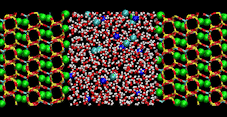Fundamental Science and Advanced Field-Scale Sensing
Intersection 1
Fundamental science and sensing combined with field-scale measurements provide a theoretical understanding of subsurface behavior and generate the critical links between geochemical subsurface processes and their field sensing signatures. This knowledge enables accurate interpretation of remotely sensed signals to confidently monitor targeted behavior.
PNNL is applying its fundamental research capabilities at the laboratory-scale to discover the underlying basis for sensing signatures of geochemical processes occurring at mineral-water interfaces to enable field-scale interrogation. Discoveries in this area support the development of new methods and instrumentation to monitor and inform on targeted subsurface processes that control behavior. Intersection 1 also provides a “playbook” for interpreting field-sensing data in terms of fundamental geochemical behavior derived from laboratory-scale investigations, including a fundamental understanding of how molecular scale fluid-mineral interactions influence field scale sensing signatures.
Intersection 1 Highlight
Reducing the need for borehole-based direct sampling

(Pacific Northwest National Laboratory)
PNNL is pioneering new approaches in electric force microscopy to understand the redistribution of ions localized at the interface between subsurface solids and fluids in response to an induced electrical field, and how relaxation of those ion distributions at zero-field yield electrical sensing signatures. This understanding provides the key to developing new sensing instrumentation aimed at remotely detecting and monitoring targeted geochemical properties and processes.

chloride anions (light blue balls)
undergo field-induced drift in opposite
direction in an aqueous solution
confined between two orthoclase surfaces.
(Pacific Northwest National Laboratory)
This research and development is directed at reducing the need for borehole-based direct sampling of geochemical properties in favor of autonomous remote subsurface monitoring, simultaneously reducing monitoring costs and uncertainty in understanding subsurface geochemical processes.